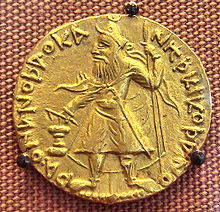Sho (letter)
 | ||||||||||||||||||||||||||||||||||||||||||||||||
| Greek alphabet | ||||||||||||||||||||||||||||||||||||||||||||||||
|---|---|---|---|---|---|---|---|---|---|---|---|---|---|---|---|---|---|---|---|---|---|---|---|---|---|---|---|---|---|---|---|---|---|---|---|---|---|---|---|---|---|---|---|---|---|---|---|---|
|
||||||||||||||||||||||||||||||||||||||||||||||||
| History | ||||||||||||||||||||||||||||||||||||||||||||||||
|
||||||||||||||||||||||||||||||||||||||||||||||||
| Diacritics and other symbols | ||||||||||||||||||||||||||||||||||||||||||||||||
| Use in other languages | ||||||||||||||||||||||||||||||||||||||||||||||||
| Related topics | ||||||||||||||||||||||||||||||||||||||||||||||||
The letter ϸ (sometimes called sho or san) was a letter added to the Greek alphabet in order to write the Bactrian language.[1] It was similar in appearance to the Anglo-Saxon and Icelandic letter thorn (þ), which has typically been used to represent it in modern print, although both are historically quite unrelated. It probably represented a sound similar to English "sh" ([ʃ]). Its conventional transliteration in Latin is ⟨š⟩.[2]


Its original name and position in the Bactrian alphabet, if it had any, are unknown. Some authors have called it "san", on the basis of the hypothesis that it was a survival or reintroduction of the archaic Greek letter San.[3] This letter ϸ closely resembles, perhaps coincidentally, the letter ⟨𐊮⟩ of the Greek-based Carian alphabet which may have also stood for [ʃ]. The name "sho" was coined for the letter for purposes of modern computer encoding in 2002, on the basis of analogy with "rho" (
Other representations of [ʃ] in the Greek alphabet
The modern Cypriot Greek dialect also has a [ʃ] sound, but it is represented with the combining caron ⟨ˇ⟩, by the authors of the "Syntychies" lexicographic database at the University of Cyprus, [4] e.g. μάσ̌
The Tsakonian language, considered a Hellenic language or a very divergent dialect of Greek, has a [ʃ] sound.
It is spelled ⟨
| Appearance | Code points | Name |
|---|---|---|
| Ϸ | U+03F7 | GREEK CAPITAL LETTER SHO |
| ϸ | U+03F8 | GREEK SMALL LETTER SHO |
References
- ^ a b c Everson, M. and Sims-Williams, N. (2002) “Proposal to add two Greek letters for Bactrian to the UCS”,ISO/IEC JTC1/SC2/WG2 N2411.
- ^ Skjærvø, P. O. (2009). "Bactrian". In Brown, Keith; Ogilvie, Sarah (eds.). Concise encyclopedia of languages of the world. Oxford: Elsevier. p. 115. ISBN 9780080877754.
- ^ Tarn, William Woodthorpe (1961). The Greeks in Bactria and India. Cambridge: Cambridge University Press. p. 508. ISBN 9781108009416.
- ^ Themistocleous et al. 2012, pp. 263–264.
- Themistocleous, Charalambos; Katsoyannou, Marianna; Armosti, Spyros; Christodoulou, Kyriaci (7–11 August 2012). Cypriot Greek Lexicography: A Reverse Dictionary of Cypriot Greek (PDF). 15th European Association for Lexicography (EURALEX) Conference. Oslo, Norway. Archived from the original (PDF) on 6 August 2016. Retrieved 12 February 2013.
